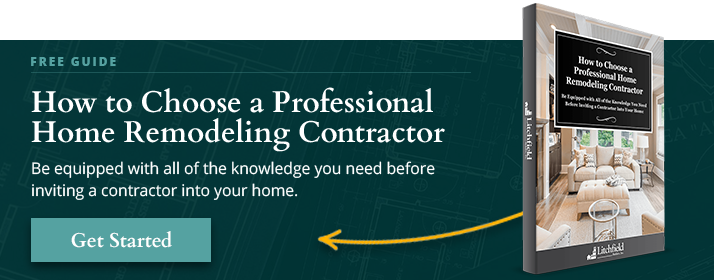Everything You Need to Know About In-Law Apartments in Connecticut
When it comes to residential construction in Connecticut, projects can vary from simple kitchen renovations to complete home remodels. As baby boomers age and increasing numbers of older children move back home, one popular home improvement has come into high demand: separate (but attached) living accommodations known as “in-law apartments.”
This type of home addition brings together families from multiple generations, allowing them to develop closer relationships and meet each other's needs at the same time.
When considering Connecticut home additions, especially for in-laws or adult children, there are several factors to consider to ensure both you and your family have the space and privacy you desire. Finding the right contractor is critical. It's also important to educate yourself about the design and construction process.
What are In-Law Apartments?
An “in-law apartment” is a small living space attached to a larger, primary residence. These secondary dwellings may also be called “mother-in-law” or “accessory apartments."
These apartments are often built over garages, and it is not uncommon for garages themselves to be converted into living quarters. Cape Cod-style homes may consider converting an attic, while most Connecticut homeowners can also convert their basements.
Homeowners with sufficient land space can have the necessary addition built onto their existing homes. A separate cottage-style unit will provide the most privacy for all residents, but depending on the location of the electrical supply and plumbing, a traditional addition may be less expensive.
Keep in mind that for accessory apartments to meet most legal requirements, units must have:
- Private Bathroom
- Kitchen
- Living Room
- Bedroom or designated Sleep Area
- An Entrance
- Laundry Facilities are common, as well
Uses for Apartments as Home Additions
In the past, families or couples added secondary suites as home additions to accommodate aging parents. This is no longer the only reason for adding accessory apartments. Multi-generational families are practical for adult children as well as aging parents, who share child-rearing responsibilities and incomes. By living on the same property, it's easier for families to ensure their loved one's well-being and ease financial burdens.
In some communities, in-law apartments may also be used as rental properties to provide extra income to the homeowner and savings to the renter. Zoning regulations determine the requirements for a rental. If you're considering building a rental apartment on your property, check with your local zoning officials to see if this type of accessory unit is possible in your area.
Challenges When Building In-Law Apartments
The construction of an in-law apartment is a big job. As a homeowner, you'll need to give thought to your project and plan it properly to ensure that your in-law apartment will be built to your specifications. At Litchfield Builders, we help homeowners build functional, stylish in-law apartments.
Electrical service. Sufficient electrical supply is critical for an in-law apartment. A home with a single 100-amp service will most likely need an upgrade to handle the electric demand of more residents.
Parking spaces. Where will everyone park? Adult occupants tend to bring their own cars, and each one needs a place to go.
Property value. The construction of an in-law suite can significantly increase the value of a home. However, if the property's value is well above the average for the neighborhood, it may not sell for that additional amount.
Meeting the needs of all individuals. People who come together into one household bring their own needs and their own vision of the way life will be when they're living together. Aging adults sometimes need accommodations to live safely in their houses - such as wider hallways and bathrooms for walkers or wheelchairs. In addition, adults often have different needs in regard to privacy and independence. These issues must be resolved before the design of the in-law suite can be completed.
Below, we will explore each of these challenges in more detail.
Building Permits
Connecticut home additions, like all residential remodeling, should be handled by professionals. For your own safety, all home additions should be completed according to local building codes, laws, and regulations. Improper work can be extremely dangerous and will not be covered by homeowner’s insurance. Unpermitted work also makes selling much more difficult and can devalue the home.
In Connecticut, though regulations vary by the city, most local regulations allow in-law apartments if rent is not being paid. If you do rent to a non-family member, you must abide by Connecticut’s landlord/tenant regulations.
Zoning Requirements
While in-law apartments are permitted in most areas of Connecticut, many communities have strict zoning laws and building regulations which vary by city. Working with a licensed contractor will help ensure that your in-law apartment is constructed properly according to the rules of your community.
This will help ensure that your in-law apartment is safe for you and your tenant. This will also help you avoid problems when it comes time to sell your home.
Electrical Supply
A typical home with 100 amp service may not have enough power to handle an apartment on the premises. This is especially true if your in-law apartment will have appliances like a refrigerator, stove, and air conditioner.
A panel box upgrade can increase the cost of an in-law apartment by thousands of dollars. Before deciding to build an in-law apartment, have your home evaluated to determine whether a new panel box is necessary.
Parking
If your in-law apartment is built to house an additional family member, your home may need additional parking. A driveway widening project may be necessary to accommodate any new cars, vans, or vehicles that will be parked on your property. Talk to your contractor to get estimates on the price of changing, building onto, or widening your driveway.
Privacy
When you and your adult family members move in together, you may find that your privacy is of great concern. Having a separate space for your family member will help make your in-law addition a success.
Give thought to privacy matters as you design your in-law apartment. Decide upfront how much space will be shared space and which spaces will be private. If possible, make the entrance to your home's in-law apartment separate from the entrance to the main home, so your family member can come and go without causing a disturbance.
Health and Physical Needs
Many in-law apartments tend to be on the upper floors of the home or even above the garage. If the family member who plans to live in this apartment is an older person, a staircase may restrict your family member's ability to enter and exit the apartment in the future.
Consider installing an alternative entrance, like a residential elevator, to ensure that your family member can enter and exit the apartment as desired.
Timelines
One more thing to consider when building an in-law apartment in Connecticut is the timeline. This major home upgrade involves dramatic changes to the structure of your home, and that takes time.
From the time that you contact a contractor to discuss your initial plans to the moment when construction begins typically takes between 60 and 90 days. In 2021, disruptions in the supply chain have impacted material availability.
Fixtures and other materials can be hard to get, which means you may take much longer to gather materials. At this time, you may wait 5 months to begin construction. Once work begins, construction takes approximately 4 to 5 months. Here's what you can expect:
- Personal planning. During the personal planning phase, you'll have conversations with family members about your plans, and have discussions about privacy, accommodations, budget, and more. It's during this phase that you'll decide whether this type of home upgrade is realistic and worth pursuing your family. Some families take only weeks to have these discussions, others take months or years.
- Finding a contractor. Once you've decided to move forward with your home improvement, you'll find a contractor. Vet several licensed, reputable contractors in your area. Talk to them about your plans. Hire a contractor that seems to understand your situation, communicates well, and can furnish excellent references.
- Design phase. Your design-build contractor will create a design and proposal with costs with allowances. Once the design is finalized, the budget can then be finalized as well. Designing can be finished in a matter of weeks if you're prompt with your responses to your contractor's inquiries.
- Gathering materials. Once the contract is signed, materials are ordered and gathered to begin construction. This phase takes several months.
- Construction. Once construction begins, finishing the project takes about 4 to 5 months, depending on the project scope.
Plan Ahead
If you're right now thinking about building an in-law apartment for your home, you could have one completed on your property in about a year. If you think that your need for an in-law suite might be urgent, get started on this project right away.
Key Takeaway
When you are considering an in-law apartment or Connecticut residential remodeling in general, discuss all the options with a licensed professional. An expert may offer you ideas you have not considered. You will also be sure that the work will be handled correctly and all legal requirements are met.
Litchfield Builders is a highly respected company with over 25 years of experience in residential remodeling in Connecticut. Click here to download our free guide, "How To Choose A Professional Home Remodeling Contractor."
About Kevin Ahern
Kevin is the Co-Founder of Litchfield Builders, an award-winning, industry leader with a reputation for managing projects others shy away from. They are known for their high-quality work, customer service, and reliability and though still relatively small in size, Litchfield Builders now competes with some of the areas largest firms in both the residential and commercial arenas.






